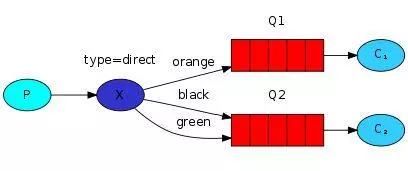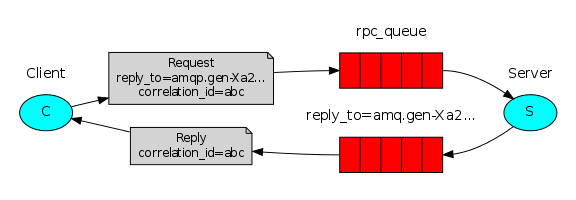一.介绍
RabbitMQ是一个在AMQP基础上完整的,可复用的企业消息系统。他遵循Mozilla Public License开源协议。
MQ全称为Message Queue, 消息队列(MQ)是一种应用程序对应用程序的通信方法。应用程序通过读写出入队列的消息(针对应用程序的数据)来通信,而无需专用连接来链接它们。消 息传递指的是程序之间通过在消息中发送数据进行通信,而不是通过直接调用彼此来通信,直接调用通常是用于诸如远程过程调用的技术。排队指的是应用程序通过 队列来通信。队列的使用除去了接收和发送应用程序同时执行的要求。
二.引入
基于Queue实现生产者消费者模型

#!/usr/bin/env python # -*- coding:utf-8 -*- import Queue import threading message = Queue.Queue(10) def producer(i): while True: message.put(i) def consumer(i): while True: msg = message.get() for i in range(12): t = threading.Thread(target=producer, args=(i,)) t.start() for i in range(10): t = threading.Thread(target=consumer, args=(i,)) t.start()
对于RabbitMQ来说,生产和消费不再针对内存里的一个Queue对象,而是在某台服务器上的RabbitMQ Server实现消息队列
实现最简单的队列通信:
#!/usr/bin/env python import pika # ######################### 生产者 ######################### connection = pika.BlockingConnection(pika.ConnectionParameters( host='localhost')) channel = connection.channel()
#声明query channel.queue_declare(queue='hello') channel.basic_publish(exchange='', routing_key='hello', body='Hello World!') print(" [x] Sent 'Hello World!'") connection.close()
#!/usr/bin/env python import pika # ########################## 消费者 ########################## connection = pika.BlockingConnection(pika.ConnectionParameters( host='localhost')) channel = connection.channel() #接收端也需要声明query,如果不声明就必须要先运行发送端,参照之前的socket通信 channel.queue_declare(queue='hello') def callback(ch, method, properties, body): print(" [x] Received %r" % body) channel.basic_consume(callback, queue='hello', no_ack=True) print(' [*] Waiting for messages. To exit press CTRL+C') channel.start_consuming()
三.几种模式
#四种交换器 fanout: 所有bind到此exchange的queue都可以接收消息 direct: 通过routingKey和exchange决定的那个唯一的queue可以接收消息 topic:所有符合routingKey(此时可以是一个表达式)的routingKey所bind的queue可以接收消息 表达式符号说明:#代表一个或多个字符,*代表任何字符 例:#.a会匹配a.a,aa.a,aaa.a等 *.a会匹配a.a,b.a,c.a等 注:使用RoutingKey为#,Exchange Type为topic的时候相当于使用fanout headers: 通过headers 来决定把消息发给哪些queue
1.work模式
在这种模式下,RabbitMQ会默认把p发的消息依次分发给各个消费者(c),跟负载均衡差不多


import pika import time connection = pika.BlockingConnection(pika.ConnectionParameters( 'localhost')) channel = connection.channel() # 声明queue channel.queue_declare(queue='task_queue') # n RabbitMQ a message can never be sent directly to the queue, it always needs to go through an exchange. import sys message = ' '.join(sys.argv[1:]) or "Hello World! %s" % time.time() channel.basic_publish(exchange='', routing_key='task_queue', body=message, properties=pika.BasicProperties( delivery_mode=2, # make message persistent ) ) print(" [x] Sent %r" % message) connection.close()

#_*_coding:utf-8_*_ import pika, time connection = pika.BlockingConnection(pika.ConnectionParameters( 'localhost')) channel = connection.channel() def callback(ch, method, properties, body): print(" [x] Received %r" % body) time.sleep(20) print(" [x] Done") print("method.delivery_tag",method.delivery_tag) ch.basic_ack(delivery_tag=method.delivery_tag) channel.basic_consume(callback, queue='task_queue', no_ack=True ) print(' [*] Waiting for messages. To exit press CTRL+C') channel.start_consuming()
启动一个发送端,启动三个接收端,通过生产者多发送几条消息,你会发现,这几条消息会被依次分配到各个消费者身上。
注意:
1)消息不丢失
设置消息应答模式no-ack = False,如果有一个消费者挂掉了,那么我们应该将分发给它的任务交付给另一个消费者去处理。
如果no-ack = True,那么如果杀死正在执行任务的消费者,会丢失正在处理的消息,也会丢失已经分发给这个消费者但尚未处理的消息。
#接受端 channel.basic_consume(callback, queue='hello', no_ack=True ) #实际上按照上面的参数顺序会报错,需要这么写 channel.basic_consume('hello',callback,False)
我们已经了解了如何确保即使消费者死亡,任务也不会丢失。但是如果RabbitMQ服务器停止,我们的任务仍将失去!
当RabbitMQ退出或者崩溃,将会丢失队列和消息。除非你不要队列和消息。
所以两件事儿必须保证消息不被丢失:我们必须把“队列”和“消息”设为持久化。
2)接受端和发送端都需要设置durable=true ,其实保证的是队列的持久化
channel.queue_declare(queue='hello', durable=True)
3)要实现消息持久化还需要设置发送端delivery_mode = 2
channel.basic_publish(exchange='', routing_key="task_queue", body=message, properties=pika.BasicProperties( delivery_mode = 2, # make message persistent ))
如果Rabbit只管按顺序把消息发到各个消费者身上,不考虑消费者负载的话,很可能出现,一个机器配置不高的消费者那里堆积了很多消息处理不完,同时配置高的消费者却一直很轻松。为解决此问题,可以在各个消费者端,配置perfetch=1,意思就是告诉RabbitMQ在我这个消费者当前消息还没处理完的时候就不要再给我发新消息了。

channel.basic_qos(prefetch_count=1)
带消息持久化+公平分发的完整代码
发送端
import pika import sys connection = pika.BlockingConnection(pika.ConnectionParameters(host='127.0.0.1')) channel = connection.channel() channel.queue_declare(queue='task_queue',durable=True) message = 'Hello World!' channel.basic_publish(exchange='',routing_key='task_queue', body=message, properties=pika.BasicProperties(delivery_mode=2,)) print('[x] sent %r' %message) connection.close()
接收端
import pika import time connection = pika.BlockingConnection(pika.ConnectionParameters( host='127.0.0.1')) channel = connection.channel() channel.queue_declare(queue='task_queue', durable=True) print(' [*] Waiting for messages. To exit press CTRL+C') def callback(ch, method, properties, body): print(" [x] Received %r" % body) time.sleep(body.count(b'.')) print(" [x] Done") ch.basic_ack(delivery_tag=method.delivery_tag) channel.basic_qos(prefetch_count=1) channel.basic_consume('task_queue',callback,False) channel.start_consuming()
2.发布/订阅模式
之前的例子基本都是1对1的消息发送和接收,即消息只能发送到指定的queue里,但有些时候你想让你的消息被所有的Queue收到,类似广播的效果,这时候就要用到exchange了,
Exchange在定义的时候是有类型的,以决定到底是哪些Queue符合条件,可以接收消息。

发送方:
import pika import sys connection = pika.BlockingConnection(pika.ConnectionParameters( host='localhost')) channel = connection.channel() channel.exchange_declare(exchange='logs', exchange_type='fanout') message = ' '.join(sys.argv[1:]) or "info: Hello World!" channel.basic_publish(exchange='logs', routing_key='', body=message) print(" [x] Sent %r" % message) connection.close()
接收方
import pika connection = pika.BlockingConnection(pika.ConnectionParameters( host='localhost')) channel = connection.channel() channel.exchange_declare(exchange='logs', exchange_type='fanout') result = channel.queue_declare(exclusive=True) #不指定queue名字,rabbit会随机分配一个名字,exclusive=True会在使用此queue的消费者断开后,自动将queue删除 queue_name = result.method.queue channel.queue_bind(exchange='logs', queue=queue_name) print(' [*] Waiting for logs. To exit press CTRL+C') def callback(ch, method, properties, body): print(" [x] %r" % body) channel.basic_consume(queue_name,callback,True) channel.start_consuming()
应用场景
比如一个商城系统需要在管理员上传商品新的图片时,前台系统必须更新图片,日志系统必须记录相应的日志,那么就可以将两个队列绑定到图片上传交换器上,一个用于前台系统更新图片,另一个用于日志系统记录日志。
3.路由模式
RabbitMQ还支持根据关键字发送,即:队列绑定关键字,发送者将数据根据关键字发送到消息exchange,exchange根据 关键字 判定应该将数据发送至指定队列。例如:我们只想把error级别的日志写到磁盘文件中,而其它级别的日志消息则过滤掉。
在这里我们将要使用direct类型的exchange。Direct类型exchange的路由算法是很简单的:要想一个消息能到达这个队列,需要binding key和routing key正好能匹配得上。

发送端
import pika import sys connection = pika.BlockingConnection(pika.ConnectionParameters( host='localhost')) channel = connection.channel() channel.exchange_declare(exchange='direct_logs', exchange_type='direct') severity = sys.argv[1] if len(sys.argv) > 1 else 'info' message = ' '.join(sys.argv[2:]) or 'Hello World!' channel.basic_publish(exchange='direct_logs', routing_key=severity, body=message) print(" [x] Sent %r:%r" % (severity, message)) connection.close()
接受端:
import pika import sys connection = pika.BlockingConnection(pika.ConnectionParameters( host='localhost')) channel = connection.channel() channel.exchange_declare(exchange='direct_logs', exchange_type='direct') result = channel.queue_declare('anne') queue_name = result.method.queue severities = sys.argv[1:] if not severities: sys.stderr.write("Usage: %s [info] [warning] [error] " % sys.argv[0]) sys.exit(1) for severity in severities: channel.queue_bind(exchange='direct_logs', queue=queue_name, routing_key=severity) print(' [*] Waiting for logs. To exit press CTRL+C')
应用场景
利用消费者能够有选择性的接收消息的特性,比如我们商城系统的后台管理系统对于商品进行修改、删除、新增操作都需要更新前台系统的界面展示,而查询操作确不需要,那么这两个队列分开接收消息就比较好。
4.主题模式
上面的路由模式是根据路由key进行完整的匹配(完全相等才发送消息),这里的通配符模式通俗的来讲就是模糊匹配。
在topic类型下,可以让队列绑定几个模糊的关键字,之后发送者将数据发送到exchange,exchange将传入”路由值“和 ”关键字“进行匹配,匹配成功,则将数据发送到指定队列。
- # 表示可以匹配 0 个 或 多个 单词
- * 表示只能匹配 一个 单词


在这个例子中,我们将会发送一些描述动物的消息。Routing key的第一个单词是描述速度的,第二个单词是描述颜色的,第三个是描述物种的:“<speed>.<colour>.<species>”。 这里我们创建三个Binding:Binding key为”.orange.”的Q1,和binding key为”..rabbit”和”lazy.#”的Q2。 这些binding可以总结为: Q1对所有橘色的(orange)的动物感兴趣; Q2希望能拿到所有兔子的(rabbit)信息,还有比较懒惰的(lazy.#)动物信息。 一条以” quick.orange.rabbit”为routing key的消息将会推送到Q1和Q2两个queue上,routing key为“lazy.orange.elephant”的消息同样会被推送到Q1和Q2上。但如果routing key为”quick.orange.fox”的话,消息只会被推送到Q1上;routing key为”lazy.brown.fox”的消息会被推送到Q2上,routing key为"lazy.pink.rabbit”的消息也会被推送到Q2上,但同一条消息只会被推送到Q2上一次。 如果在发送消息时所指定的exchange和routing key在消费者端没有对应的exchange和binding key与之绑定的话,那么这条消息将会被丢弃掉。例如:"orange"和"quick.orange.male.rabbit"。但是routing为”lazy.orange.male.rabbit”的消息,将会被推到Q2上。
发送方
#!/usr/bin/env python import pika import sys connection = pika.BlockingConnection(pika.ConnectionParameters( host='localhost')) channel = connection.channel() channel.exchange_declare(exchange='topic_logs', exchange_type='topic') routing_key = sys.argv[1] if len(sys.argv) > 1 else 'anonymous.info' message = ' '.join(sys.argv[2:]) or 'Hello World!' channel.basic_publish(exchange='topic_logs', routing_key=routing_key, body=message) print(" [x] Sent %r:%r" % (routing_key, message)) connection.close()
接收方
#!/usr/bin/env python import pika import sys connection = pika.BlockingConnection(pika.ConnectionParameters( host='localhost')) channel = connection.channel() channel.exchange_declare(exchange='topic_logs', exchange_type='topic') result = channel.queue_declare(exclusive=True) queue_name = result.method.queue binding_keys = sys.argv[1:] if not binding_keys: sys.stderr.write("Usage: %s [binding_key]... " % sys.argv[0]) sys.exit(1) for binding_key in binding_keys: channel.queue_bind(exchange='topic_logs', queue=queue_name, routing_key=binding_key) print(' [*] Waiting for logs. To exit press CTRL+C') def callback(ch, method, properties, body): print(" [x] %r:%r" % (method.routing_key, body)) channel.basic_consume(queue_name, callback, True) channel.start_consuming()
总结:
关于 RabbitMQ 的五种队列,其实实际使用最多的是最后一种主题模式,通过模糊匹配,使得操作更加自如。那么我们总结一下有交换器参与的队列(最后三种队列)工作方式如下
生产者:
1.链接Rabbit MQ--->2.获取信道--->3.声明交换器--->4.创建消息--->5.发布消息--->6.关闭信道--->7.关闭链接
消费者:
1.链接Rabbit MQ--->2.获取信道--->3.声明交换器--->4.声明队列--->5.把队列和交换器绑定-->6.消费消息--->7.关闭信道--->8.关闭链接
四.远程调用(RPC)
前面介绍的都是一个发送方,一个接收方,如果我们发送方发送了之后想从接收方获取结果呢?

首先,发送方发送请求时,声明结果返回的队列(即结果返回时到哪个队列取结果),并在发送消息时将需要返回结果的队列以及生成的corr_id一并发送,
接收方收到请求后,将结果发送到指定的队列,并附带上corr_id。
最后原先的发送方再到指定的队列取结果。
实现一个远程调用斐波那契数列
RPC server
import pika import time connection = pika.BlockingConnection(pika.ConnectionParameters( host='localhost')) channel = connection.channel() channel.queue_declare(queue='rpc_queue') #绑定取消息的队列 def fib(n): if n == 0: return 0 elif n == 1: return 1 else: return fib(n - 1) + fib(n - 2) #处理请求的方法 def on_request(ch, method, props, body): n = int(body) #消息主题为str格式需要转成int print(" [.] fib(%s)" % n) response = fib(n) #调用fib(),生成返回结果 ch.basic_publish(exchange='', routing_key=props.reply_to,#返回指定队列 properties=pika.BasicProperties(correlation_id= props.correlation_id),#将请求附带的correlation_id返回 body=str(response)) #将结果转成str返回 ch.basic_ack(delivery_tag=method.delivery_tag) channel.basic_qos(prefetch_count=1) channel.basic_consume('rpc_queue',on_request) #从rpc_queue取消息,并调用on_request方法处理 print(" [x] Awaiting RPC requests") channel.start_consuming()
RPC client
import pika import uuid class FibonacciRpcClient(object): def __init__(self): self.connection = pika.BlockingConnection(pika.ConnectionParameters( host='localhost')) self.channel = self.connection.channel() result = self.channel.queue_declare('anne') #绑定返回队列,随机生成 self.callback_queue = result.method.queue self.channel.basic_consume(self.callback_queue,self.on_response,True, ) #从绑定的返回队列取结果 def on_response(self, ch, method, props, body): if self.corr_id == props.correlation_id: #检测是否与发送的corr_id一致 self.response = body #取出返回结果传给response def call(self, n): self.response = None self.corr_id = str(uuid.uuid4()) #生成唯一的corr_id self.channel.basic_publish(exchange='', routing_key='rpc_queue', #发送的队列 properties=pika.BasicProperties( reply_to=self.callback_queue, #返回的队列 correlation_id=self.corr_id, #发送corr_id ), body=str(n))#消息主体 while self.response is None: self.connection.process_data_events() return int(self.response) fibonacci_rpc = FibonacciRpcClient() print(" [x] Requesting fib(30)") response = fibonacci_rpc.call(30) #调用Call()方法 print(" [.] Got %r" % response) #打印返回结果
